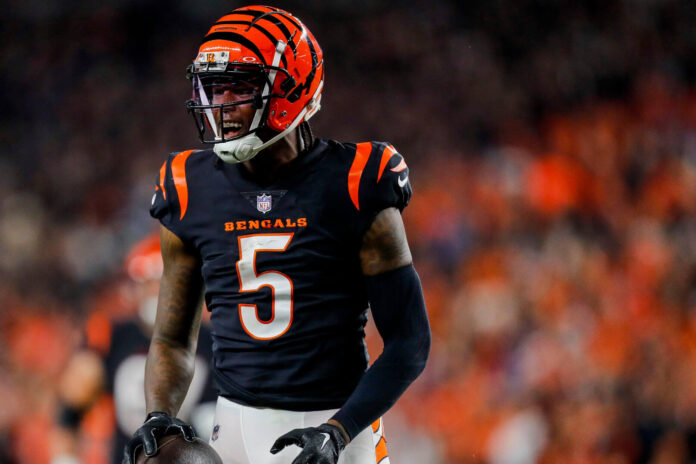[ad_1]
Longtime Bengals fans can rip off the answer faster than you can say “Pontiac Silverdome turf.”
Team President Mike Brown probably could do it faster.
When was the last time the Cincinnati Bengals traded up in the first round? The year was 1995. The player was Ki-Jana Carter. The injury was a torn ACL in the preseason against the Lions.
Every year since, the Bengals have either stayed put, or three times slid back in the opening round, casually making their pick and going about their business.

Free, daily NFL updates direct to your inbox. Sign up
Free, daily NFL updates direct to your inbox. Sign up
They’re not one to get cute and maneuver with the most high-profile draft asset.
As the draft tradewinds begin to blow with Stefon Diggs shipped to the Texans on Wednesday and Tee Higgins’ trade request still hanging in the air like an ominous rain cloud above Paycor Stadium, could this be the year the Bengals perform their latest buck of a franchise tradition?
Probably not if leaning into history, need, draft strength and current messaging. But the Bengals possess more enticing options than most to consider.
Latest Growler with @ByJayMorrison:
🔄 Trade show! Analyzing chances of #Bengals draft weekend movement from all angles
😳 One thing Duke Tobin has NEVER done
☁️ Could a draft weekend deal for Tee Higgins happen?
📺: https://t.co/dZ8bFB4ERc pic.twitter.com/Bert3A790v
— Paul Dehner Jr. (@pauldehnerjr) April 3, 2024
Trading up?
A straight trade up might be the least likely of all scenarios. It’s easy to be mesmerized every year by the blue-chip prospects and possibilities, but director of player personnel Duke Tobin will never be that guy.
Not only have the Bengals never moved up in the first round since his arrival, but the only time they moved up in the second round came two years ago when they jumped from 63 to 60 to snag Cam Taylor-Britt. Tobin later bemoaned having to make the move but recognized Taylor-Britt was too good of a fit and giving up just a sixth-round pick in exchange was a small price to pay.
But that’s it. They live off quantity over quality, believing more swings will produce more hits. They have 10 swings in this draft and four in the top 100.
Bengals’ first-round trades since Ki-Jana Carter in 1995
• 2018: Back from 12 to 21 (received Cordy Glenn & R5 pick swap)
• 2012: Back from 21-27 for Kevin Zeitler (received 93)
• 2004: Back twice from 17-24-26 for Chris Perry (received 117 and 123)

The Bengals traded up with the Panthers from No. 5 to No. 1 in 1995 to take Penn State running back Ki-Jana Carter but have never made such a big draft-day move since. Carter tore an ACL in his first preseason game. (Focus on Sport via Getty Images)
Recent history of pick-for-pick trades in the middle of the first round suggests any move up into the early teens would require at least a third-round pick, probably more. Tobin has three selections between 80 and 115, but also big plans for those. Giving those up might require a courtesy health check call to ensure he’s still conscious.
Understanding the rarity of moving up also requires understanding the current situation. With an obvious need at right tackle and a collection of top prospects ranked in the consensus top 20, the extreme likelihood involves Cincinnati staying and picking once again, with right tackles Troy Fautanu, JC Latham and Amarius Mims among the leaders in the clubhouse.
One very public difference exists this year, though.
The question of the offseason — laid out in four parts — saw gasoline poured on it when Higgins’ camp went public with a trade request the morning free agency began. His frustration with the application of the franchise tag didn’t shake the Bengals’ front office, which remains resolute on having Higgins return this season in an attempt to win the Super Bowl.
That doesn’t mean the opportunity to deal him (and the $21.8 million tag) evaporates. It will only ramp up as these three days play out.
Buffalo shipped a disgruntled Diggs to Houston on Wednesday in exchange for a 2025 second-round pick and swapping of 2024 and 2025 late-rounders.
Diggs is 30 years old versus Higgins at 25 and a far higher level of frustration bubbling for a Buffalo team hitting reset with younger players as Josh Allen’s money truly impacts the roster. The Bengals aren’t there yet. They are still in the process of going for it with Higgins and are enthused to do so.
That doesn’t mean a potential draft-day trade would garner the type of substantial haul Cincinnati would need to make such a significant move.

GO DEEPER
Bengals mock draft 1.0: Free agency crystallizes 7-round path, focus remains on OT/DT
Edge rusher Brian Burns was traded on the franchise tag from the Panthers to the Jets last month in exchange for the 39th pick and a 2025 fifth-rounder. He was given a contract exceeding what Higgins should expect ($28 million APY and $87.5 million guaranteed). It’s hard to see Cincinnati receiving better compensation than that.
In fact, the Chiefs, more desperate to unload franchise-tagged corner L’Jarius Sneed, only received a 2025 third-rounder and late-round pick swap. Beyond that, Broncos receiver Jerry Jeudy only required a fifth- and sixth-rounder from Cleveland last month. Keenan Allen went to the Bears for a fourth-round pick.
All these factors would suggest dreams of a first-round pick in compensation wouldn’t fall close to the current market. Thus, shifting out of the Bengals’ consideration.
There’s always the theory involving the Bengals using Higgins (and another pick or two) as a tool to move up with a team in the top 10 to land one of the big three receivers in Malik Nabers, Marvin Harrison Jr. or Rome Odunze. Sounds fun and bold, of course. On top of the fact a team trading for Higgins would just select one of the big three, the idea of giving up Higgins, No. 18 and at least another pick would also be the most stunning, out-of-character move in team history — and another health check to the Bengals’ draft room.
If seeking a slightly more realistic sweet spot, both the Cardinals (27 and 35) and Patriots (34) need receivers, have picks at the top of the second round and rank in the top 10 in cap space. To a lesser degree, throw in the Jaguars at No. 48. If there was a middle ground to consider for both sides, that could be one to consider if Cincinnati felt passionately about one of the receivers on the board — the same as when they rebuffed trade offers and selected Higgins at No. 33 in 2020.
Would they take four years of, say, Georgia’s Ladd McConkey on a rookie deal versus one season of Higgins at $21.8 million straight up? Would they even receive an offer that tasty? Only Tobin can answer the question definitively today.
We know the Bengals view Higgins as an integral part of their plan and executive vice president Katie Blackburn even kept the door open to a long-term deal with Higgins after this year when talking at the league meetings. Still, the option, if presented, would be enticing.
Trading down?
The number of offensive tackles and allure of the second tier of receivers in the area where Cincinnati selects could open itself up for a move back.
Recent pick-for-pick trades offer a template for the expected compensation of a move back into the mid-20s.
• 2022: The Chiefs gave up 94 and 121 to move from 29 to 21 (equivalent to mid-third)
• 2021: The Jets gave up 66, 86 and 143 to move from 23 to 14 (equivalent to mid-second)
A typical compensation would be Arizona’s 27 and 66 for the Bengals’ 18.
Compare two top-100 hauls from two different paths.
Trade back in R1:
• 27. Tyler Guyton, OT, Oklahoma
• 49. T’Vondre Sweat, DT, Texas
• 66. Roman Wilson, WR, Michigan
• 80. Mike Sainristil, CB, Michigan
• 97. Christian Mahogany, IOL, Boston College
No movement:
• 18. JC Latham, OT, Alabama
• 49. T’Vondre Sweat, DT, Texas
• 80. Jermaine Burton, WR, Alabama
• 97. Christian Mahogany, IOL, Boston College
This isn’t about the specific players listed, as much as positional strategy. Checking one extra box does a notable job of filling out the major roster priorities while taking advantage of the depth at both tackle and receiver. Is that worth the drop-off on the tackle pick considering the team has Trent Brown as the current starter? Probably.
Taking advantage of the first five rounds will be important in a draft thin at the back due to NIL and extra years keeping a significant number of would-be draft entrants in school.
Early-entry declarations:
• 2019: 135
• 2020: 115
• 2021: 128
• 2022: 100
• 2023: 82
• 2024: 54
The chances of landing this year’s Andrei Iosivas in the sixth round are substantially lower than previous seasons.
The Bengals own four picks in the final two rounds. Using those as ammo to move up and pinpoint and acquire specific prospects they target in the middle rounds will be an important strategy to monitor.
It also lends to the most utilized strategy in recent Bengals’ drafting history. Cincinnati has moved back in the second round to acquire an extra mid-round selection four times in the last seven drafts. Each instance involved moving back 8-10 spots to land at least one extra selection in the top 130.
• 2021: Back eight spots from 38-46 for Jackson Carman (received 122 and 139)
• 2019: Back 10 spots from 42-52 for Drew Sample (received 125 and 182)
• 2018: Back eight spots from 46-54 for Jessie Bates (moved up from 100 to 78)
• 2017: Back seven spots from 41-48 for Joe Mixon (received 128)
This would serve as another strategy capable of allowing the Bengals to focus on attacking the strong middle rounds of this draft. The Bengals are a roster without many starting openings but center Ted Karras, slot corner Mike Hilton, right tackle Trent Brown and defensive tackle BJ Hill are all free agents after this season and will be at least 30 years old in 2025. None have a clear, young successor (except maybe Dax Hill for Hilton). Plus, they are still seeking competition to replace DJ Reader (Lions) and Tyler Boyd (free agent). The same goes for an eventual heir to Higgins at WR2.
They can’t expect the draft to solve every long-term issue, but if filling the pipeline with future starters is the goal, they’d better come from the top three rounds.
Since the 2020 draft, 12 homegrown picks have started at least five games for the Bengals in their career. Only two — Cordell Volson (fourth round, 136 overall) and Hakeem Adeniji (sixth, 180) — were picked after the third round.

GO DEEPER
Bengals’ free-agent approach aims for an explosive turnaround
Growing the number of picks in the top 100 from four to six or seven could make the difference in creating sustainability of the starting roster through the meat of Joe Burrow’s contract.
The Bengals enter this draft with extra picks, advantageous positioning, one significant asset and many options.
They are well-positioned for movement. Nobody is predicting another Ki-Jana bomb, but considering how close this team has been to winning it all, the stakes of success versus failure might be just as high.
(Top photo: Katie Stratman / USA Today)
[ad_2]
Source link


